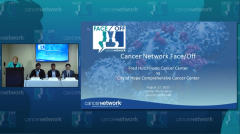
Debate on Efficacy and Patient Selection With Ixa-Pom-Dex in Relapsed/Refractory MM
Leading experts discuss the potential benefits and challenges of using ixazomib pomalidomide-dexamethasone as a treatment option for relapsed myeloma patients, considering factors like efficacy, overall survival, and patient demographics.
Transcript:
Judy Schreiber, PhD, RN: Now we’ll go to questions from the home team here at City of Hope.
Murali Janakiram, MD, MS: Dr Banerjee, we know we can never beat you in puns.... If we continue this study to overall survival [OS], do you think there will be [OS] difference, or do you think [there is] something biological about ixazomib that we are not seeing [OS] difference? I agree with in which patients you would use it, but I’m still puzzled…why the results are not coming out.
Rahul Banerjee, MD, FACP: It’s an excellent question, Dr Janakiram. It alludes to what you had brought up earlier, that there [are] still no [OS] data from any of the TOURMALINE studies. Or if I recall clearly, there was an [American Society of Hematology] abstract…either last year or 2 years ago, where they pooled data from TOURMALINE-MM3 and TOURMALINE-MM4 [NCT02181413; NCT02312258]—so ixazomib vs placebo in the maintenance setting—and still no [OS] benefit. You could argue [that with] maintenance, [it’s] a little tougher to show an [OS] benefit, but I think it’s important here. The reason I would argue…with ixazomib is we…keep going with the theme [that] for our older, frailer patients, [it] may be helpful. But I don’t think it’s necessarily as powerful as dara-Kd [daratumumab/carfilzomib/dexamethasone] or isa-Kd, and [it’s] certainly not as powerful as CAR T [chimeric antigen receptor T-cell therapy] in terms of PFS [progression-free survival].
Again, if you look at CARTITUDE-4 [NCT04181827] data…you’ll see that if I had to choose between ixazomib Pd and CAR T, I would probably choose the latter. Even for patients where CAR T is not available [in the] second line, where right now we’re using [it] fifth line…onward, I would argue that having such good therapies in later lines makes it very difficult to show an [OS] benefit here. You may ask about a potential PFS2 benefit with ixazomib Pd vs Pd, [but] I would still argue it’s going to be very difficult and tricky to show, because again, these patients from when the study accrued are almost certainly CD38 naïve. And I would argue that putting these patients—no matter what arm they got—on third-line dara-Kd or isa-Kd would negate any potential PFS2 benefit to this. [I] would love to hear [all] your takes.
Andrew J. Cowan, MD: You can’t ignore a PFS of 20 months. That’s numerically better than for example, inotuzumab [plus pomalidomide and dexamethasone]. I agree with you, [Dr Banerjee], but on the other hand, I also know that we can’t get CAR T to every patient. If I knew I could start ixa-pom-dex [ixazomib/pomalidomide/dexamethasone] and keep that patient stable until they get to CAR T, I think that’s a win. I’m of the opinion that the more options we have for treating relapsed multiple myeloma, the better. Even if some might be perceived to be less effective, an option is an option…. For example—and this is not meaning to be ixazomib—if a drug works in 1 of 10 patients, I’m still going to use it because…why not? You can try to play the chess game with multiple myeloma and really try to map it out, or you can just use what you have best at hand. I’ve…become more of the latter chess player rather than the grand strategy, but maybe I’m doing it all wrong. I’m interested in Dr Janakiram’s take on that, as well.
Murali Janakiram, MD, MS: I agree. It’s definitely good to have options, and I agree with Dr Banerjee regarding the other trials as well. As you said, Dr Cowan, this can be a reasonable bridging therapy, especially if a person is coming from a rural area where we know disparities to access [are] the highest. Ixa-pom-dex is a good regimen, [and] ixazomib [plus lenalidomide and dexamethasone]—I think those are definitely fine apart from the frail population, which we are talking [about]. And [because] most of us treat very refractory myeloma, we know that it’s always good to have options. And this will be a good option in select patients at this time, yes.
Lawrence W. Liu, MD: Yes, I agree with the previously mentioned points. The one thing is, like what you pointed out [regarding] the red flags, I would be very hesitant to use a regimen [where] I don’t know infection data, I don’t know cytopenia, that sort of thing. I want to see what the manuscript shows. Even if it were a regimen with a high rate of infections and cytopenias, at least I know the data and I know what to tell the patient and how frequently to see the patient. That’s the tough thing…exactly like you brought up. But I think it’ll be interesting to see what the manuscript reports.
Judy Schreiber, PhD, RN: Are there any questions from the audience at either [location]?
Audience Member: Hi, I’m Adam…part of the [Dr] Liu fan club. I was just wondering how things are going to change now that anti-CD38 [agents] are going to be moving into the beginning of therapy for multiple myeloma. Would that change your excitement about something like this when you have…dara RVD [daratumumab/lenalidomide/bortezomib/dexamethasone] becoming a more popular frontline therapy?
Murali Janakiram, MD, MS: That’s a very interesting question, because what I’m seeing is there are trials [that] are actually dropping the PI [proteosome inhibitor] in the first-line setting. So now PI might be used in the first relapse setting, then it’ll open up options for ixazomib and bortezomib. I think some of the trials are comparing CAR-T [with] dara Rd and replacing like for like, and the PI is the one [that] is being dropped. Who knows how the future might change. I’m interested in listening to opinions from our other colleagues.
Rahul Banerjee, MD, FACP: I agree, that’s an excellent question. I will add that ixa Pd…could also be a very late-line regimen. But I…argue [that] post–CAR T relapse, which has happened to a lot of our patients—we’ve published data from my prior [institution], [University of California, San Francisco], and Mount Sinai has done [studies] as well—any of these options are fair game because some of those patients might have indolent relapses. But [for] relapses with CAR-T, there is no standard of care for post–CAR T relapse. I would argue [that] ixa-pom-dex—they’re all oral. Those patients are already going to be cytopenic [and] would be coming in for labs. That would be an attractive bet there. I do think the optimal place of ixa Pd is constantly being shifted in either direction, but we may see it having a renaissance at a place we don’t expect it to be.
Transcript is AI generated and edited for clarity and readability.
Newsletter
Stay up to date on recent advances in the multidisciplinary approach to cancer.























































































